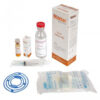Widebac IV Infusion (50mg/vial)
558.00৳
Generic: Tigecycline INN 50mg
Type: Infusion
Pack Size: 1 Pc
Description:
Indications
Tigecycline is indicated for the treatment of infections caused by susceptible strains of the designated
Microorganisms in the conditions listed below-
1. Complicated Skin and Skin Structure Infections:
Complicated skin and skin structure infections caused by Escherichia coli, Enterococcus faecalis (vancomycin-susceptible isolates only), Staphylococcus aureus (methicillin-susceptible and -resistant isolates), Streptococcus agalactiae, Streptococcus anginosus grp. (includes S. anginosus, S. intermedius, and S. constellatus), Streptococcus pyogenes, Enterobacter cloacae, Klebsiella pneumonia and Bacteroides fragilis.
2. Complicated Intra-Abdominal Infections:
Complicated intra-abdominal infections caused by Citrobacter freundii, Enterobacter cloacae, Escherichia coli, Klebsiella oxytoca, Klebsiella pneumoniae, Enterococcus faecalis (vancomycin-susceptible isolates only), Staphylococcus aureus (methicillin-susceptible and resistant isolates), Streptococcus anginosus grp. (includes S. anginosus, S. intermedius, and S. constellatus), Bacteroides fragilis, Bacteroides thetaiotaomicron, Bacteroides uniformis, Bacteroides vulgatus, Clostridium perfringens, and Peptostreptococcus micros.
3. Community-Acquired Bacterial Pneumonia:
Community-acquired bacterial pneumonia caused by Streptococcus pneumoniae (penicillin-susceptible isolates), including cases with concurrent bacteremia, Haemophilus influenzae (beta-lactamase negative isolates), and Legionella pneumophila.
Pharmacology
Tigecycline is a glycylcycline that inhibits protein translation in bacteria by attaching to the 30S ribosomal subunit and preventing amino-acyl tRNA molecules from entering the ribosome’s A site. This prevents amino acid residues from being incorporated into elongating peptide chains. Tigecycline has a glycylamido moiety linked to the minocycline 9-position. The substitution pattern is unique to tigecycline and is not seen in any naturally occurring or semisynthetic tetracycline. It gives it microbiologic characteristics.The two principal tetracycline resistance mechanisms, ribosome protection and efflux, have no effect on tigecycline. As a result, tigecycline has been shown to be effective against a wide range of bacterial infections in vitro and in vivo. There has been no evidence of tigecycline and other antibiotics causing cross resistance. Resistance mechanisms including beta-lactamases (including extended spectrum beta-lactamases), target site alterations, macrolide efflux pumps, or enzyme target changes (e.g. gyrase/topoisomerase) have no effect on tigecycline. Antagonism between tigecycline and other regularly used antibacterial medicines has not been observed in vitro. In general, tigecycline is thought to be safe.
Dosage & Administration
The duration of therapy should be guided by the severity and site of the infection and the patient’s clinical and bacteriological progress. The recommended duration of treatment with Tigecycline for complicated skin and skin structure infections or for complicated intra-abdominal infections is 5 to 14 days and forcommunity-acquired bacterial pneumonia is 7 to 14 days. The recommended daily dose is as follows-
Adults:
The recommended dosage regimen for Tigecycline is an initial dose of 100 mg, followed by 50 mg every 12hours. Intravenous (IV) infusions of Tigecycline should be administered over approximately 30 to 60 Minutes every 12 hours.
Pediatric use:
Safety and effectiveness in pediatric patients below the age of 18 years have not been established.
Geriatric use:
No unexpected overall differences in safety or effectiveness were observed between these subjects and younger subjects
Interaction
Drug interaction of Tigecycline with Digoxin and Warfarin is observed
Contraindications
Tigecycline should not be used in patients who have a history of Tigecycline hypersensitivity.
Side Effects
The most common treatment-emergent adverse events are nausea and vomiting which generally occurred during the first 1-2 days of therapy. The following drug-related adverse events are reported infrequently in patients receiving Tigecycline-
Injection site inflammation & pain, septic shock, allergic reaction, chills, thrombophlebitis, bradycardia, tachycardia, vasodilatation, anorexia, dry mouth, hypoglycemia, hyponatremia, prolonged prothrombin time, eosinophilia, thrombocytopenia, vaginal moniliasis, vaginitis, leukorrhea.
Pregnancy & Lactation
Pregnancy:Tigecycline should be used during pregnancy only if the potential benefit justifies the potential risk to the fetus.
Lactation:Caution should be exercised when Tigecycline is administered to a nursing woman
Precautions & Warnings
Tigecycline is structurally similar to Tetracycline-class antibiotics and should be administered with caution in patients with known hypersensitivity to Tetracycline-class antibiotics.
Pharmaceutical precaution:
Before reconstitution, Tigecycline should be stored at 20?C to 25?C. Once reconstituted, Tigecycline may be stored at room temperature for up to 24 hours (up to 6 hours in the vial and the remaining time in the intravenous bag). Reconstituted solution may be stored refrigerated at 2?C to 8?C for up to 48 hours following the immediate transfer of reconstituted solution into the intravenous bag
Storage Conditions
Tigecycline should be stored at 20?C to 25?C before reconstitution. Tigecycline can be stored at room temperature for up to 24 hours once reconstituted (up to 6 hours in the vial and the remaining time in the intravenous bag). Following the quick transfer of reconstituted solution into the IV bag, the solution can be kept refrigerated at 2?C to 8?C for up to 48 hours.







Reviews
There are no reviews yet.